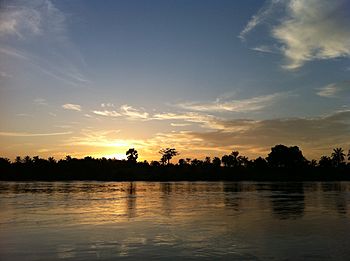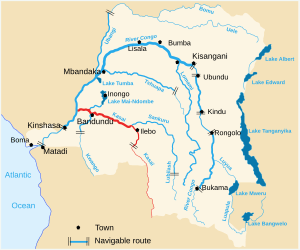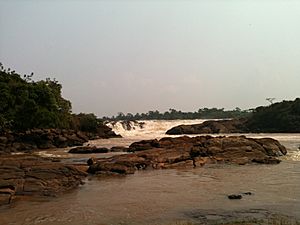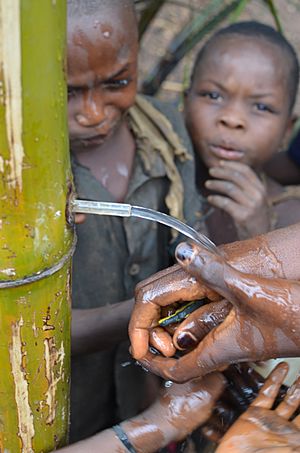Kasai River facts for kids
Quick facts for kids Kasai River |
|
|---|---|
 |
|

Kasai River (in red) as part of Congo River system
|
|
| Physical characteristics | |
| River mouth | Congo River |
| Length | 2,153 km (1,338 mi) |
| Basin features | |
| Basin size | 881,890 km2 (340,500 sq mi) |
The Kasai River (also called Cassai in Angola) is a large river in Central Africa. It is a major tributary that flows into the Congo River. The Kasai River starts in central Angola. It flows east, then turns north, forming part of the border between Angola and the Democratic Republic of the Congo (DRC).
After entering the DRC, the river flows past Ilebo. Here, it meets the Lulua and Sankuru rivers. The lower part of the Kasai River is known as the Kwa(h) River after it joins the Fimi River. Finally, it flows into the Congo River near Kwamouth. The area around the Kasai River is mostly covered by rainforests. This region is known for its valuable diamond deposits. In fact, many diamonds processed in Belgium come from the Kasai River area.
River's Role in Trade and Travel
The rivers that flow into the Kasai River are easy to travel on. This makes them important for moving goods and people. In the past, these rivers were a key trade route. They were especially important during the 18th and 19th centuries.
One of its main branches, the Kwango River, was used by traders. They traveled through the dense rainforest. These activities had a lasting impact on the local population. Even today, some areas have fewer people than places not affected by this history.
Diamonds of the Kasai River
The Kasai River is famous for its rich diamond deposits. Many diamonds are found near where the river meets the Congo River. More diamonds are also found along the Kwango River, a major tributary of the Kasai.
The Kwango River valley is sometimes called "the diamond heartland of North Eastern Angola." This is because it has some of the richest diamond beds in Angola. These valuable gems have attracted a lot of attention to the region.
Images for kids
See also
 In Spanish: Río Kasai para niños
In Spanish: Río Kasai para niños




